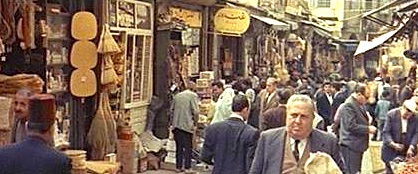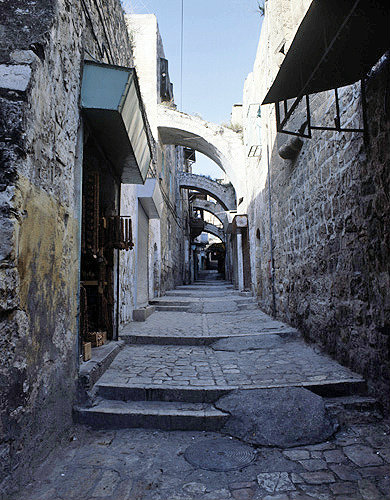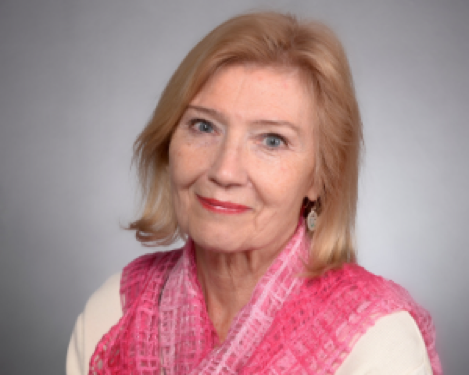Fifty-one years ago, this week, I was in East Jerusalem surrounded by the past, confronting the present, and trying to imagine the future, but I was also energized to be in the place where King David reigned, Mohammed walked, and Christ died.
On Christmas Eve, at an Episcopal Mass in Seattle, I had difficulty focusing on the sermon and though the subject matter was mainstream – fake “post-truth” news and the birth of Christ – my mind was in that earlier time and place. As the Bishop spoke I thought about the Holy Land as crucible, how it was 51 years ago, how it is now, and what the differences mean to all of us.
Israel was 17 years’ old in 1965 – a baby state. I was 27 years old, a baby myself. We were just 10 years apart in age, the Jewish state and I. Its people were ecstatic, determined, and hopeful with thousands of immigrants flooding into the newly established promised land. I was young, optimistic, and seeing the wider world for the first time. But there were signs of trouble; I couldn’t cross the border from East Jerusalem into Israel because the stamp in my passport prevented me from crossing back to the Arab world, and I was aware that though the Jews had their new homeland the indigenous Arab population and thousands of displaced Palestinians did not. I was naïve. I thought everything could be worked out.
I was there in the Middle East mostly by default. After six weeks on the island of Crete I wanted to see more of the Levant and flew to Beirut on a student ticket. On the way I met a small group of Peace Corps volunteers traveling on Christmas leave from their posts in Turkey. In Beirut they were joined by Bonnie Landes, another volunteer, who had traveled from her village by bus. I was invited to join the group and over the course of the next few days we became friends and explored Beirut.

Pre-war Beirut was one of the world’s great cities. Situated on the eastern edge of the Mediterranean it was a blended culture of French, British, Christian, Muslim, and Arab populations. In the ‘60s it was the commercial and cultural center of the Levant. Oil companies from Saudi Arabia and North Africa were headquartered there. Modern business interests contrasted with the ancient gold souk. French cuisine competed for my taste buds with Muslim halal, and the Casino du Liban featured Paris-like Lido shows with showgirls who were oggled, purchased, and feted by Arab sheikhs.
After a week in the Paris of the Middle East I was ready to move on, but the Peace Corps group wanted to stay. All, that is, except Bonnie who was as curious as I was about seeing more of the Holy Land. When I asked if she wanted to share a ride to Jerusalem she didn’t hesitate. The two of us took off the next morning in a “dolmus” or shared taxi with two Arab locals to drive to Jerusalem via Damascus and Amman.
This new adventure was as exotic as anything I had ever done, crossing from the eastern edge of the Mediterranean, through the cedar covered mountains of Lebanon, and down to the sand colored plains of Syria. The drive was uneventful, for me, but in Damascus Bonnie asked me to change places with her because the Arab seated next to her had active hands. When we rearranged ourselves and I moved to the middle his hands quieted down.
The stop at the central market square in Damascus, where we dropped off one passenger and pick up another, gave us time to look around. I’d never been anywhere like it – the noise, the smells, the sights. There were Arabs in caftans and keffiyehs, businessmen in suits, camels and donkeys bleating and defecating, sidewalk vendors selling everything from pots and pans to Persian carpets. And… a square full of Arab men shamelessly staring at my pretty blond companion.
After the stop in Damascus we continued on our way to Jerusalem and for the next few days, leading up to Christmas, we explored the old city and nearby historic sites – Bethlehem, Jericho and Petra. We looked in on the Church of the Nativity and walked the Stations of the Cross on the Via Dolorosa. At the Jordan River, barely a trickle at that point, we watched American folksinger, Julie Felix, sing Michael Row the Boat Ashore for a documentary film crew while sitting in a rowboat on the muddy ditch that was the Jordan.
 After the Jewish state was established in 1948, the holy city of Jerusalem, sacred to the world’s three great religions, was divided in half. The modern Western portion was incorporated into the new state, and the “Old City,” including the holy sites of The Wailing Wall, Dome of the Rock, and the Via Dolorosa ceded to the bordering state of Jordan. That was the situation when I was there in 1965.
After the Jewish state was established in 1948, the holy city of Jerusalem, sacred to the world’s three great religions, was divided in half. The modern Western portion was incorporated into the new state, and the “Old City,” including the holy sites of The Wailing Wall, Dome of the Rock, and the Via Dolorosa ceded to the bordering state of Jordan. That was the situation when I was there in 1965.
I loved the old city. Arab vendors sitting cross-legged on Turkish carpets surrounded by open burlap bags of coffee, tea, and spices. Pilgrims in sackcloth walking the Stations of the Cross with enormous wooden crosses and crowns of thorns. Coptic and Orthodox priests preaching to small crowds on street corners. Hasidic Jews with side curls and black hats walking ahead as their families followed a few paces behind. Tour guides giving their spiels to camera-loaded tourists. It was a feast for the eyes, ears, and nostrils.

In 1967 that world was gone. The world I had seen was gone in six days… With a preemptive strike Israeli aircraft destroyed the Egyptian and Syrian air forces and exposed Egyptian ground troops in the Sinai to the well-armed, well-trained Israeli military. In six days it was all over and Israel was in control of the Sinai, Gaza, West Bank, the Old City, and Golan Heights. It has been that way ever since.
Many have tried to work out a solution that would accommodate both Israel and the Palestinians who have never found their own homeland. In 1979 Anwar Sadat, Egypt’s President and Menachem Begin of Israel signed a peace treaty based on Jimmy Carter’s Camp David Accords. Sadat was later murdered by Muslim extremists and the deal fell apart. Then in 1993 the Oslo Accords were proposed by Bill Clinton as a setup for a two-state solution, and the agreement was signed by Yitzhak Rabin for Israel and Yasser Arafat for the Palestinians. But, Oslo II was never signed and the plan fell through again. Rabin was murdered and Israel made a hard turn to the right with Benjamin Netanyahu and the Likud Party.
Since then, under Netanyahu’s leadership, Israel has expanded its control over the West Bank, building new settlements in the occupied area and denying Palestinian residents free movement. Last Friday the United Nations Security Council passed a resolution censuring Israel and demanding immediate cessation of West Bank expansion. The vote was 14-0 (including France, UK, Spain, Japan, Russia, China, Egypt, and New Zealand) with the US abstaining.
In the thin-skinned manner of Donald Trump, Prime Minister Benjamin Netanyahu lashed out at President Obama for his “shameful ambush” of the Jewish state while threatening the other Security Council members with retribution. The Jewish settlements are in clear violation of international law, most notably UN Resolution 242 passed in 1967 and agreed to by both sides in laying out the parameters of a negotiated two-state agreement. Netanyahu’s Israel is not the Israel of Golda Meir, Yitzhak Rabin, or Shimon Peres. His leadership style is that of a bully with his foot on the neck of a poor neighbor. I, for one, am proud that my President had the courage to stand up to Netanyahu’s shameless expansionism.
Now what? Jimmy Carter recently offered a solution in his book, Palestine Peace Not Apartheid. Another is being proposed by a Jewish organization called J Street that advocates an end to settlement expansion and promotion of a Palestinian state. Ari Shavit, the Israeli writer of My Problem Land, sees doom for Israel if it doesn’t craft a solution that provides for its Arab population and others displaced by the Jewish state.
I don’t have a solution. I just know that paranoia and aggressive, disrespectful, expansionist behavior is not moving either side toward a viable solution. Today (December 28) Secretary of State John Kerry answered Netanyahu and outlined the US position by offering a punch list of steps that could lead to reopened negotiations and a two-state solution. I believe there are other moderates who are capable of crafting a diplomatic solution. They may have to go back to earlier agreements and appeal to new partners, but nothing will be accomplished as long as the Israeli leadership remains intransigent and inflexible. I understand that the solution needs to ensure Israel’s security, but simultaneously it needs to respect the humanity of the Palestinian people. It requires creative diplomacy, less saber rattling and strong international support to back it up.
Though I’m discouraged by the current state of affairs, my time in the Middle East was life altering. I learned to listen and appreciate how other cultures lived, sounded, looked, smelled and tasted. I learned to appreciate their differences, and I made a lifelong friend in Bonnie Landes.
Bonnie returned to her Peace Corps post when we parted. She met and married an American-educated Turk, had a son (American college educated), worked at the American Embassy in Ankara for 30+ years and retired recently. We’ve seen each other twice in the years since our days in Beirut and Jerusalem, once in Chicago when she was home visiting her family and once in Ankara when I was on a Pan Am layover.
It’s always fun to see her although there was some serious tension attending the Ankara visit. When she came to the hotel she let me know that her husband was out of town and if her brother-in-law caught us together he would kill us both. And… that was before “radical Islamic extremism.” We ended up talking in my room instead of the bar. Today, she’s divorced and back in the States, although she and her son still have deep ties to Turkey.
I don’t know what triggered the Christmas Eve memories. I’ve been to many midnight services at St. Mark’s in the last 15 years. I love the smells and bells, the rituals, the music, and the vestments., but that night something triggered the memory that took me back to Christmas Eve in Jerusalem 51 years ago and a deep gratitude for both the memories and the friendship.
Epilogue
My one small regret about the 1965 experience is that I don’t have any pictures from that time. My father gave me a small Argus C3 camera when I graduated from college and though I loved other people’s photographs I hated the whole complicated and expensive process of buying film, changing rolls, waiting for the pictures to be developed and then throwing away all but a handful. I gave away the Argus the day before I left on this trip because I didn’t want to be fumbling with the camera and missing the experience in front of me.
Today I’m infatuated with the iPhone camera and use it indiscriminately. I’m only sorry I don’t have pictures from those Middle Eastern adventures. My memories of the sights are extraordinary and I don’t regret the decision to ditch the camera but I wish I had those missing images. I’ve picked a few pictures off the Internet but they don’t really tell the story.
































Thank you, Jack. Your insights with historical timeline really put this issue in perspective.
Hi Jack, This is the first time I have read your blog and I think I am hooked! Ha! Very interesting account of a fascinating time in your life. There is no substitute for the experience of travel. It opens the mind and stimulates one’e thinking. Your account of spending time in the Milddle East caused me to think of our experiences in Israel while circumnavigating in 1984. We had just come from exploring the antiquity of Egypt after sailing up the Red Sea and transiting the Suez Canal. About 10 miles off the Israeli coast the noise of an Israeli reconnasises plane buzzed us quite low and within 5 miniutes an old US PT boat flying the Israeli flag came along side. The captain hailed us with a megaphone asking us to show him our passports. Laurie quickly went below and came on deck with two passports and 2 kids in her arms, along with Jamee, our 10 year old daughter. He quickly gave us the go ahead and yelled, “Welcome to Israel”! We sailed into Haifa from Port Said in a about 5 hours including the fascinating interruption. These Jews were serious about intruders off their coast. We were aware that Haifa is a seaport on the West Bank, acquired by the Isrealis during the 6 Days War. I radioed the harbor master on VHF and got permission to tie up at the Haifa Yacht Club. An American sounding man took our bow and stern lines helping us to tie up. More later!
Jack, Insightful comments on history versus Netanyahu’s approach. I enjoy your blog so very much.